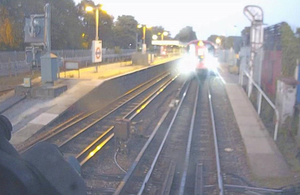Report 04/2021: Signal passed at danger and subsequent near miss, Chalfont & Latimer station
RAIB has today released its report into a signal passed at danger and subsequent near miss, Chalfont & Latimer station, 21 June 2020.

Forward-facing CCTV image from southbound train, showing stopping positions of the trains involved (image courtesy of Chiltern Railways)
Summary
At around 21:43 hrs on Sunday 21 June 2020, a near miss occurred between two passenger trains at London Underground’s Chalfont & Latimer station on the Metropolitan line. A few minutes earlier a southbound Chiltern Railways train had passed a signal displaying a red (stop) aspect (known as a signal passed at danger or a ‘SPAD’). This resulted in the train being automatically stopped by a safety system, known as a tripcock, which had applied the train’s emergency brake. Without seeking the authority required from the service operator (signaller), the driver reset the tripcock before continuing towards Chalfont & Latimer station, where the train was routed towards the northbound platform, which was occupied by a London Underground train.
The Chiltern Railways train stopped about 23 metres before reaching the other train, which was stationary. There were no reported injuries, but there was minor damage to signalling equipment and a set of points.
The probable cause of the SPAD was that the driver of the Chiltern Railways train was fatigued. The driver stated that he decided to proceed without authority because he did not recall passing the stop signal and believed the tripcock safety system activation had been spurious. This decision may also have been affected by fatigue.
RAIB found that Chiltern Railways’ processes for training and testing a driver’s knowledge of what to do following a tripcock activation were not effective. A probable underlying factor was that Chiltern Railways’ driver management processes did not effectively manage safety-related risk associated with the driver involved in the incident. It is possible that this was a consequence of a high turnover of driver managers, insufficient driver managers in post and their high workload. Although not causes of the incident, RAIB also found shortcomings in other aspects of these driver management processes, and in risk management at the interface between Chiltern Railways and London Underground.
Recommendations
RAIB has made three recommendations and identified one learning point. The first recommends that Chiltern Railways improves its driver management processes. The second recommends that Chiltern Railways and London Underground Ltd jointly establish an effective process for the management of safety at the interfaces between their respective operations. The third recommends that Chiltern Railways, assisted by London Underground, reviews the risk associated with resetting train protection equipment applicable to Chiltern Railways’ trains on London Underground infrastructure. The learning point concerns the importance of considering sleep disorders during routine medical examinations of safety critical workers.
Notes to editors
- The sole purpose of RAIB investigations is to prevent future accidents and incidents and improve railway safety. RAIB does not establish blame, liability or carry out prosecutions.
- RAIB operates, as far as possible, in an open and transparent manner. While our investigations are completely independent of the railway industry, we do maintain close liaison with railway companies and if we discover matters that may affect the safety of the railway, we make sure that information about them is circulated to the right people as soon as possible, and certainly long before publication of our final report.
- For media enquiries, please call 01932 440015.